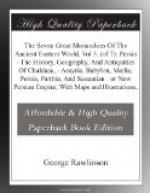The spirit of the Zendavesta is wholly averse to idolatry, and we may fully accept the statement of Herodotus that images of the gods were entirely unknown to the Persians. Still, they did not deny themselves a certain use of symbolic representations of their deities, nor did they even scruple to adopt from idolatrous nations the forms of their religious symbolism. The winged circle, with or without the addition of a human figure, which was in Assyria the emblem of the chief Assyrian deity, Asshur, became with the Persians the ordinary representation of the Supreme God, Ormazd, and, as such, was placed in most conspicuous positions on their rock tombs and on their buildings. [PLATE LVIII., Fig. 7.] Nor was the general idea only of the emblem adopted, but all the details of the Assyrian model were followed, with one exception. The human figure of the Assyrian original wore the close-fitting tunic, with short sleeves, which was the ordinary costume in Assyria, and had on its head the horned cap which marked a god or a genius. In the Persian counterpart this costume was exchanged for the Median robe, and a tiara, which was sometimes that proper to the king,23 sometimes that worn with the Median robe by court officers. [PLATE LVIII., Fig. 7.]
Mithra, or the Sun, is represented in Persian sculptures by a disk or orb, which is not four-rayed like the Assyrian, but perfectly plain and simple. In sculptures where the emblems of Ormazd and Mithra occur together, the position of the former is central, that of the latter towards the right hand of the tablet. The solar emblem is universal on sculptured tombs, but is otherwise of rare occurrence.
Spirits of good and evil, the Ahuras and Devas of the mythology, were represented by the Persians under human, animal, or monstrous forms. There can be little doubt that it is a good genius—perhaps the “well-formed, swift, tall Serosh”—who appears on one of the square pillars set up by Cyrus at Pasargadae. This figure is that of a colossal man, from whose shoulders issue four wings, two of which spread upwards above his head, while the other two droop and reach nearly to his feet. [PLATE LIX.] It stands erect, in profile, with both arms raised and the hands open. The costume of the figure is remarkable. It consists of a long fringed robe reaching from the neck to the ankles—apparently of a stiff material, which conceals the form—and of a very singular head-dress. This is a striped cap, closely fitting the head, overshadowed by an elaborate ornament, of a character purely Egyptian. First there rise from the top of the cap two twisted horns, which, spreading right and left, become a sort of basis for the other forms to rest upon. These consist of two grotesque human-headed figures, one at either side, and of a complex triple ornament between them, clumsily imitated from a far more elegant Egyptian model. [PLATE LX., Fig. 1.]
[Illustration: PLATE LIX.]




